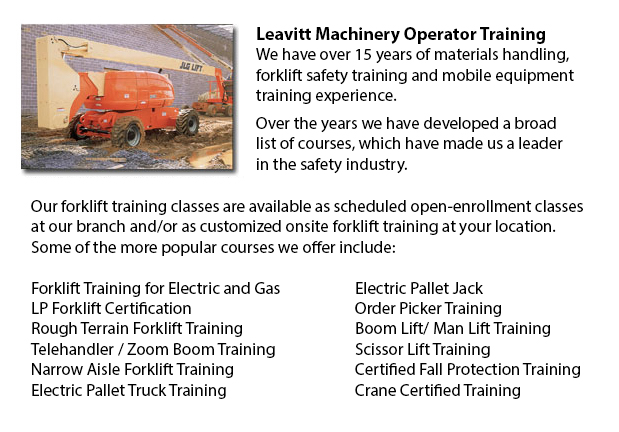
Aerial Lift Safety Training Saskatchewan - Each and every year, there are approximately 26 construction fatalities attributed to the use of aerial lifts. Most of the craftsmen killed are laborers, electrical workers, carpenters, painters or ironworkers. Nearly all deaths are caused by electrocutions, falls and tip-overs. The greatest hazard is from boom-supported lifts, like for example cherry pickers and bucket trucks. Most deaths are connected to this type of lift, with the rest involving scissor lifts. Other risks include being struck by falling objects, being thrown out of a bucket, and being caught between the guardrail or lift bucket and an object, like for example a steel beam or joist.
To safely operate an aerial lift, perform an inspection on the following things prior to using the device: operating and emergency controls, safety devices (such as, outriggers and guardrails), personal fall protection gear, and wheels and tires. Check for possible leaks in the air, fuel-system, hydraulic fluid. Inspect the device for loose or missing components.
The area where the device would be used should be thoroughly examined for possible hazards, such as holes, bumps, debris and drop-offs. Overhead power lines should be closely monitored or avoided. It is suggested that aerial lift devices be utilized on surfaces which are stable and level. Don't work on steep slopes which go beyond slope limitations which the manufacturer specified. Even on a level slope, outriggers, brakes and wheel chocks should be set.
Employers are required to provide maintenance mechanics and aerial lift operators with the correct manuals. Operators and mechanics must be trained by a qualified person experienced with the applicable aerial lift model.
Aerial Lift Safety Tips:
o Close lift platform chains or doors prior to operating.
o Do not lean over or climb on guardrails. Stand on the platform or floor of the bucket.
o Stay within manufacturer's load-capacity restrictions.
o When working near traffic, make use of right work-zone warnings, such as signs and cones.
Electrocutions are avoidable if safety procedures are followed. Stay as far away from power lines - at least 10 feet. Qualified electrical workers should insulate and/or de-energize power lines. Individuals working should utilize personal protective tools and equipment, such as a bucket which is insulated. Then again, an insulated bucket does not protect from electrocution if, for example, the individual working touches another wire providing a path to the ground.
Falls are avoidable if the individual working remains secure in guardrails or inside the bucket by utilizing a full-body harness or a positioning device. If there is an anchorage inside the bucket, a positioning belt along with a short lanyard is acceptable.
Tip-overs are avoidable by following the manufacturer's instructions. Unless the manufacturer specifies otherwise, never drive when the lift platform is elevated. Adhere to the device's horizontal and vertical reach limitations, and never go beyond the load-capacity that is specified.
-
Forklift Ticket Saskatchewan
Forklift Ticket Saskatchewan - Pallet jacks and forklifts are both meant for basically the same purpose; to move supplies from one location of your warehouse to another. This is pretty much where the comparison stops however. With the pallet jack, th... More -
Loader Ticket Saskatchewan
Loader Ticket Saskatchewan - Gehl articulated loaders have been made to suit practically any condition. They provide great traction and optimal maneuverability due to a heavy-duty oscillating joint that offers forty five degree rotating angles left a... More -
Forklift Training Programs Saskatchewan
Forklift Training Programs Saskatchewan - Are you searching for work as a forklift driver? Our regulatory-compliant mobile equipment operator training provides instruction in kinds of forklifts, pre-shift check, fuel kinds and handling of fuels, and... More -
Heavy Equipment Operator Classes Saskatchewan
Heavy Equipment Operator Classes Saskatchewan - A heavy equipment operator is an individual who has received the right training in order to operate a particular kind or piece of machinery. There are lots of ways for the operator to undergo training a... More -
Telehandler Training in Saskatchewan
Telescopic handlers usually known as telehandlers for short, are an extremely popular piece of heavy construction equipment. They are usually utilized in the construction and agricultural trades. These equipments have farthest reaching capacity and a... More -
Narrow Aisle Forklift / Order Picker Training / Electric Pallet Jack / Electric Pallet Truck Training in Saskatchewan
A pallet lift is a piece of equipment dedicated in the transporting of pallets of various dimensions and weights. They can be utilized as an attachment for forklifts, cranes and other types of heavy machinery or be applied on their own. Pallet lifts... More -
Operator Safety Training, Re-Qualification Training, In-House Instructor Training in Saskatchewan
Used in just about all industrial construction sites, warehouse operations or boat yards, the lift truck is a very important component so as to help pick up and transfer supplies. The reach feature of a forklift can help improve the applications whic... More -
Aerial Lift Ticket Saskatchewan
Aerial Lift Ticket Saskatchewan - Boom vehicle are often used by phone, cable and utilities firms as they have extended folded arms which are generally folded over the roofs of business vehicles. On the end of the extension of extendable arms usually... More

Forklift Training Saskatchewan
TOLL FREE: 1-888-254-6157
Saskatoon, Saskatchewan
forklifttrainingsaskatchewan.com
Email Us
About Us



